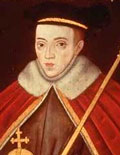 |
Edward Vb. 2 Nov 1470, Westminster [1] |
| Title: | Dei Gracia Rex Anglie et Francie Dominus Hibernie (By the Grace of God, King of England and France and Lord of Ireland) |
| Term: | 9 Apr 1483 - 25 Jun 1483 |
| Chronology: | 9 Apr 1483, succeeded his father, Edward IV (proclaimed in London 11 Apr 1483; not crowned) |
| 4 May 1483, arrived in London | |
| 25 Jun 1483, throne declared vacant by an assembly of the three estates of the realm | |
| Names/titles: | Original name: Edward Plantagenet; Prince of Wales and Earl of Chester (from 26 Jun 1471 [formal grant on 17 Jul 1471]); Earl of Flint and Duke of Cornwall (from 17 Jul 1471); Earl of March and Earl of Pembroke (from 8 Jul 1479) |
| Biography: | |
Edward was the oldest surviving son of King Edward IV and Elizabeth Woodville. Being created Prince of Wales in 1471, Edward lived in Ludlow Castle, Shropshire, under the tutelage of his maternal uncle Anthony Woodville, 2nd Earl Rivers. He was notified of his father's death on 14 Apr 1483 and departed for London (24 Apr 1483) accompanied by his uncle. En route to London, the dukes of Gloucester and Buckingham took custody of the king's person and arrested his maternal relatives (30 Apr 1483, at Stoney Startford, near Northampton). On 4 May 1483 Edward V and the Duke of Gloucester entered London. The king's Council confirmed the status of Gloucester as Protector of the Realm as appointed by Edward IV's last will in mid-May 1483. By writs dated 13 May 1483 Parliament was summoned to meet on 25 Jun 1483. However, on 17 Jun 1483 writs of supersedeas, cancelling the writs of election, were sent out, but not received everywhere. On 22 Jun 1483 Edward V was denounced as a bastard and thus illegitimate with no right to the English throne by Dr. Ralph Shaa, a cleric, at St. Paul's cross. His sermon was followed by the address of Duke of Buckingham, who urged Gloucester's title to the crown at a large meeting in the London Guildhall (24 Jun 1483). On 25 Jun 1483 those, who had responded to the parliament summons, assembled at Westminster. Although not a parliament, this assembly issued a petition to Gloucester in which they declared that the throne was vacant and that the Duke had to accept the succession, lest they choose someone else. On 26 Jul 1483 Richard accepted the throne and became king as Richard III. Edward and his younger brother Richard Duke of York lived in the Tower of London during the summer of 1483, but their further fate is unknown. It is possible they were murdered on orders of Richard. Skeletons found in the Tower in 1674, thought to be those of the princes were later buried in Westminster Abbey. [2; 3] |
|
| | |
| [1] | "One of the first things Edward did on returning to London was visit the Queen, who on the night he took ship from King's Lynn had taken sanctuary at Westminster with her daughters: Elizaneth, Mary and Cecily. There, on All Souls' Day, 2 November 1470, she gave birth to Prince Edward." [2] |
| [2] | "The Year of Three Kings", by Giles St Aubyn (Collins: London, 1983) |
| [3] | Handbook of British Chronology (1986) |
| Image: portrait of King Edward V by unknown artist, late 16th century (?). | |
